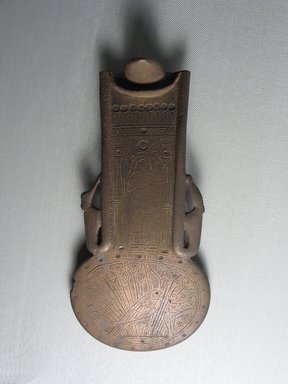
Medium: Bronze
Geograhical Locations:
Dates:664–30 B.C.E.
Dimensions: 8 5/16 x 4 3/16 x 1 5/8 in. (21.1 x 10.7 x 4.2 cm)
Collections:
Accession Number: 37.1586E
Image: CUR.37.1586E_view1.jpg,
Catalogue Description: Over life-size bronze menat. The front surface is decorated in the following manner. Two uraei-the one to the left wearing the red crown and the one to the right wearing the white crown-flank the upper portion of the menat. This part of the menat is decorated with a representation of a frieze of uraei below which is a figure of a goddess, wearing cow’s horns and solar disk, nursing a young nude king (or Horus) wearing the double crown. Flanking this central scene are papyrus columns. Behind the goddess is written di ankh: before her is Djed medew (in) Aset. This decoration is mainly executed in incised lines. The sunk disk atop Isis’ head, however is treated as a circular line in sunk relief. Also sunk below the surface are the disk of the winged disk below the frieze of uraei, the circular forms from which the papyrus columns rise, and the central portions of the umbels of those two columns. These areas may have been meant to receive inlays; and the sunken portion of the support of one of the columns has some metal sunk into it. This is silver in color, but it is not certain that it is ancient. The lower portion of the menat, oval in shape, is decorated in the following manner. Within a border of groups of three incised lines alternating with single and sunken small circles (insets?) in a representation of a falcon, wearing the double crown with uraeus. The falcon strides atop a serpent and is set against a clump of papyrus. This representation is executed in incised lines; but the falcon’s eye is a hollow as if it were meant to receive an inlay. The rear surface is plain except for a thick median rib. The entire piece curves convexly toward the front. Projecting out towards the rear at the top are two eyelets. Condition: Dark patina in spots. Lower portion of menat is chipped.